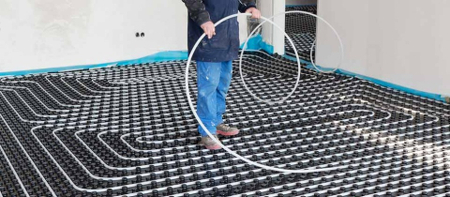There is no doubt that radiant floor heat is a superior method of heating your home. Its popularity is steadily increasing as people discover that is it not only the most comfortable form of heating but also the most cost efficient.

Though comfort and cost are the two biggest benefits of this heating system there are many others:
- Silent operation – no hum or whistle of a forced air system.
- Inconspicuousness of the system – you don’t see vents or air blowing.
- A healthier home – forced air systems can spread dust, pollen, and germs.
- Even, quiet warmth: even with wood, tile, or uncovered concrete floors.
- Also, radiant heat is less likely to dry out your breathing passages and skin.
The warmth of the floor on a cold winter morning would probably be enough to convince a lot of people that radiant floor heating is the best thing since sliced bread. However, after discovering the cost savings, there is usually no going back.
Radiant floor heating concentrates the heat in the lower half of a room where the human body needs it most. Since heat is evenly distributed in the floor, the thermostat can be set 2 ñ 4∞ less than a forced air heating system. This can reduce energy cost by 10-30%. Homes and building with a high ceiling will save even more in heating costs as heat generated by forced air systems quickly rises to the top of these structures, where it is of little use.
Whereas a forced air system delivers heat that quickly rises to the ceiling ñ a radiant floor heating system radiates heat from the floor and distributes the heat evenly throughout the rooms.
In a radiant floor heating system, warm water circulates through tubing beneath the floor. This turns the flooring into an efficient, low-temperature radiator.
Though Radiant Floor heating is not a complicated system, there are components that are required, and that the homeowner should be aware of the heating source, the Pump and the tubing.
The heating source can be electricity, solar, natural gas, propane, oil, wood, or any other heating source.
The boiler, with a certified efficiency rating, houses the water to be heated. This same boiler can also be used to heat the pool, snow melting, heating a hot tub, or and domestic hot water needs.
A Pump is required to circulate the water through the tubing located under the floor.
The tubing for a radiant floor heating system is located either in the concrete, under wood subfloors, or on a subfloor of wood, precast concrete or concrete slab-on-grade, then covered with gypsum.
Once a homeowner makes the decision to install a radiant floor heating system, contacting the right installer is imperative.
Some companies who design radiant floor heating systems may also install the system.
A good System Designer and a qualified System Installer will work together and know which components work well together, capacities of various systems, special considerations for installations in your area, and manufacturersí warranties and reliability.
The designer should do a room-by-room heat loss analysis of your home or building done as well as a step-by-step system sizing process.
